Digital Technologies and Circular Economy in the Construction Sector: A Review of Lifecycle Applications, Integrations, Potential, and Limitations
Abstract
1. Introduction
2. Methods
3. Results
3.1. Digital Technologies for Circular Economy and Their Application Along a Building’s Lifecycle
3.1.1. Building Information Modeling (BIM)
3.1.2. Spatial Data Acquisition
3.1.3. Artificial Intelligence and Machine Learning
3.1.4. Internet of Things (IoT)
3.1.5. Blockchain
3.1.6. Digital Twin
3.1.7. Augmented Reality and Virtual Reality (AR and VR)
3.1.8. Digital Platform/Marketplace
3.1.9. Material Passports
3.1.10. Additive Manufacturing and Digital Fabrication
3.2. Digital Technologies and the Barriers for a Circular Economy Transition in the Construction Industry
3.2.1. Design
3.2.2. Policies and Standards
3.2.3. Assessment Methods
3.2.4. Business Model
3.3. Digitalization and the Integration of Tools for CE in the AEC Industry
3.4. Digital Technology Limitations and Future Research Needs
3.4.1. Data Management Challenges
3.4.2. BIM and GIS Limitations and Clarity Issues
3.4.3. Validation and Automation Challenges
3.4.4. Collaboration and Knowledge Management Challenges
4. Discussion
5. Conclusions
Author Contributions
Funding
Conflicts of Interest
Appendix A. Literature Review
| Search Criteria or String Combination | Results | |
|---|---|---|
|
Initial search to identify DTs | (“circular economy” OR “circular city”) AND (“built environment” OR “building” OR “construction”) AND (“digitalization” OR “digital technology” OR “Industry 4.0”) | 120 |
| Backward snowballing | Searching for relevant articles within the references of the papers found above | 59 |
| Follow-up searches within each DT identified in the initial search | ||
| BIM | (“circular economy” OR “circular city”) AND ("built environment" OR "building" OR "construction") AND ("BIM") | 41 |
| Virtual reality | (“circular economy” OR “circular city") AND ("built environment" OR "building" OR "construction") AND ("VR" OR “Virtual Reality”) | 31 |
| Internet of things | (“circular economy” OR “circular city") AND ("built environment" OR "building" OR "construction") AND ("IoT" OR “Internet of Things”) | 30 |
| Material passport | (“circular economy” OR “circular city") AND ("built environment" OR "building" OR "construction") AND ("Material Passport") | 14 |
| Digital platform | (“circular economy” OR “circular city") AND ("built environment" OR "building" OR "construction") AND ("Digital Platform") | 34 |
| Digital twin | (“circular economy” OR “circular city") AND ("built environment" OR "building" OR "construction") AND ("Digital twin") | 33 |
| Artificial intelligence and machine learning | (“circular economy” OR “circular city") AND ("built environment" OR "building" OR "construction") AND ("Artificial Intelligence” OR “Machine Learning”) | 74 |
| Blockchain | (“circular economy” OR “circular city") AND ("built environment" OR "building" OR "construction") AND ("Blockchain") | 113 |
| Additive manufacturing or digital fabrication | (“circular economy” OR “circular city") AND ("built environment" OR "building" OR "construction") AND ("Additive manufacturing" OR “Digital Fabrication”) | 34 |
| Spatial data acquisition | (“circular economy” OR “circular city") AND ("built environment" OR "building" OR "construction") AND ("LiDAR" OR "Spatial Data Acquisition" OR “GIS” OR "Laser scan*" OR "Scan-to-BIM" OR "SLAM" OR "TLS" OR "Photogrammetry" OR "UAV") | 24 |
| Filter 1 | Peer-reviewed journal articles and conference proceedings only; 2015-2023, in English | 607 |
| Filter 2 | Abstract and keywords search: abstracts mentioning CE or CE principles (e.g., reuse, recycle, remanufacture, deconstruction, repair, etc.) AND keywords including CE principles | 183 |
| Filter 3 | Full text scanning: articles strictly related to CE and its principles and focused on the AEC industry | 71 |
References
- Islam, M.T.; Iyer-Raniga, U.; Trewick, S. Recycling Perspectives of Circular Business Models: A Review. Recycling 2022, 7, 79. [Google Scholar] [CrossRef]
- Keles, C. Evaluating the Effect of Building Envelope on Thermal Performance in Cold and Warm Climate Regions of Turkey. Eur. J. Eng. Sci. Technol. 2020, 3, 93–104. [Google Scholar] [CrossRef][Green Version]
- UNEP. Global Alliance for Buildings and Construction: Towards a Zero-Emissions, Efficient and Resilient Buildings and Construction Sector; UNEP: Nairobi, Kenya, 2020. [Google Scholar]
- United Nations Environment Programme. 2020 Global Status Report for Buildings and Construction: Towards a Zero-Emissions, Efficient and Resilient Buildings and Construction Sector; United Nations Environment Programme: Nairobi, Kenya, 2020. [Google Scholar]
- United States Environmental Protection Agency; Office of Land and Emergency Management. Advancing Sustainable Materials Management: 2018 Fact Sheet Assessing Trends in Materials Generation and Management in the United States; United States Environmental Protection Agency: Washington, DC, USA, 2020.
- Çetin, S.; De Wolf, C.; Bocken, N. Circular Digital Built Environment: An Emerging Framework. Sustainability 2021, 13, 6348. [Google Scholar] [CrossRef]
- Geissdoerfer, M.; Savaget, P.; Bocken, N.M.P.; Hultink, E.J. The Circular Economy—A New Sustainability Paradigm? J. Clean. Prod. 2017, 143, 757–768. [Google Scholar] [CrossRef]
- Konietzko, J.; Bocken, N.; Hultink, E.J. Circular Ecosystem Innovation: An Initial Set of Principles. J. Clean. Prod. 2020, 253, 119942. [Google Scholar] [CrossRef]
- Bocken, N.M.P.; de Pauw, I.; Bakker, C.; van der Grinten, B. Product Design and Business Model Strategies for a Circular Economy. J. Ind. Prod. Eng. 2016, 33, 308–320. [Google Scholar] [CrossRef]
- MacArthur, E. Towards the Circular Economy: Opportunities for the Consumer Goods Sector; Ellen MacArthur Foundation: Isle of Wight, UK, 2013; pp. 1–112. [Google Scholar]
- Wuni, I.Y. Drivers of Circular Economy Adoption in the Construction Industry: A Systematic Review and Conceptual Model. Build. Res. Inf. 2023, 51, 816–833. [Google Scholar] [CrossRef]
- Cruz Rios, F.; Grau, D.; Bilec, M. Barriers and Enablers to Circular Building Design in the US: An Empirical Study. J. Constr. Eng. Manag. 2021, 147. [Google Scholar] [CrossRef]
- Ghisellini, P.; Ripa, M.; Ulgiati, S. Exploring Environmental and Economic Costs and Benefits of a Circular Economy Approach to the Construction and Demolition Sector. A Literature Review. J. Clean. Prod. 2018, 178, 618–643. [Google Scholar] [CrossRef]
- Hart, J.; Adams, K.; Giesekam, J.; Tingley, D.D.; Pomponi, F. Barriers and Drivers in a Circular Economy: The Case of the Built Environment. Procedia CIRP 2019, 80, 619–624. [Google Scholar] [CrossRef]
- Hossain, M.U.; Ng, S.T. Critical Consideration of Buildings’ Environmental Impact Assessment towards Adoption of Circular Economy: An Analytical Review. J. Clean. Prod. 2018, 205, 763–780. [Google Scholar] [CrossRef]
- Pomponi, F.; Moncaster, A. Circular Economy for the Built Environment: A Research Framework. J. Clean. Prod. 2017, 143, 710–718. [Google Scholar] [CrossRef]
- Gasparri, E.; Arasteh, S.; Kuru, A.; Stracchi, P.; Brambilla, A. Circular Economy in Construction: A Systematic Review of Knowledge Gaps towards a Novel Research Framework. Front. Built Environ. 2023, 9, 1239757. [Google Scholar] [CrossRef]
- Yu, Y.; Yazan, D.M.; Junjan, V.; Iacob, M.-E. Circular Economy in the Construction Industry: A Review of Decision Support Tools Based on Information & Communication Technologies. J. Clean. Prod. 2022, 349, 131335. [Google Scholar] [CrossRef]
- Caldas, L.R.; Silva, M.V.; Silva, V.P.; Carvalho, M.T.M.; Filho, R.D.T. How Different Tools Contribute to Climate Change Mitigation in a Circular Building Environment?—A Systematic Literature Review. Sustainability 2022, 14, 3759. [Google Scholar] [CrossRef]
- Crippa, M.; Guizzardi, D.; Schaaf, E.; Monforti-Ferrario, F.; Quadrelli, R.; Risquez Martin, A.; Rossi, S.; Vignati, E.; Muntean, M.; Brandao De Melo, J.; et al. GHG Emissions of All World Countries; European Commission: Brussels, Belgium, 2023. [Google Scholar]
- Ingemarsdotter, E.; Jamsin, E.; Kortuem, G.; Balkenende, R. Circular Strategies Enabled by the Internet of Things-a Framework and Analysis of Current Practice. Sustainability 2019, 11, 5689. [Google Scholar] [CrossRef]
- Rusch, M.; Schöggl, J.P.; Baumgartner, R.J. Application of Digital Technologies for Sustainable Product Management in a Circular Economy: A Review. Bus. Strategy Environ. 2023, 32, 1159–1174. [Google Scholar] [CrossRef]
- Setaki, F.; van Timmeren, A. Disruptive Technologies for a Circular Building Industry. Build. Environ. 2022, 223, 109394. [Google Scholar] [CrossRef]
- Akhimien, N.G.; Latif, E.; Hou, S.S. Application of Circular Economy Principles in Buildings: A Systematic Review. J. Build. Eng. 2021, 38, 102041. [Google Scholar] [CrossRef]
- Li, C.Z.; Zhao, Y.; Xiao, B.; Yu, B.; Tam, V.W.Y.; Chen, Z.; Ya, Y. Research Trend of the Application of Information Technologies in Construction and Demolition Waste Management. J. Clean. Prod. 2020, 263, 121458. [Google Scholar] [CrossRef]
- Honic, M.; Ferschin, P.; Breitfuss, D.; Cencic, O.; Gourlis, G.; Kovacic, I.; De Wolf, C. Framework for the Assessment of the Existing Building Stock through BIM and GIS. Dev. Built Environ. 2023, 13, 100110. [Google Scholar] [CrossRef]
- Schaubroeck, S.; Dewil, R.; Allacker, K. Circularity of Building Stocks: Modelling Building Joints and Their Disassembly in a 3D City Model. Procedia CIRP 2022, 105, 712–720. [Google Scholar] [CrossRef]
- Akanbi, L.A.; Oyedele, L.O.; Akinade, O.O.; Ajayi, A.O.; Davila Delgado, M.; Bilal, M.; Bello, S.A. Salvaging Building Materials in a Circular Economy: A BIM-Based Whole-Life Performance Estimator. Resour. Conserv. Recycl. 2018, 129, 175–186. [Google Scholar] [CrossRef]
- Elghaish, F.; Hosseini, M.R.; Kocaturk, T.; Arashpour, M.; Bararzadeh Ledari, M. Digitalised Circular Construction Supply Chain: An Integrated BIM-Blockchain Solution. Autom. Constr. 2023, 148, 104746. [Google Scholar] [CrossRef]
- Xue, K.; Uzzal Hossain, M.; Liu, M.; Ma, M.; Zhang, Y.; Hu, M.; Chen, X.; Cao, G. Bim Integrated Lca for Promoting Circular Economy towards Sustainable Construction: An Analytical Review. Sustainability 2021, 13, 1310. [Google Scholar] [CrossRef]
- Xing, K.; Kim, K.P.; Ness, D. Cloud-BIM Enabled Cyber-physical Data and Service Platforms for Building Component Reuse. Sustainability 2020, 12, 329. [Google Scholar] [CrossRef]
- Gordon, M.; Batallé, A.; De Wolf, C.; Sollazzo, A.; Dubor, A.; Wang, T. Automating Building Element Detection for Deconstruction Planning and Material Reuse: A Case Study. Autom. Constr. 2023, 146, 104697. [Google Scholar] [CrossRef]
- van den Berg, M.; Voordijk, H.; Adriaanse, A. BIM Uses for Deconstruction: An Activity-Theoretical Perspective on Reorganising End-of-Life Practices. Constr. Manag. Econ. 2021, 39, 323–339. [Google Scholar] [CrossRef]
- Charef, R. Supporting Construction Stakeholders with the Circular Economy: A Trans-Scaler Framework to Understand the Holistic Approach. Clean. Eng. Technol. 2022, 8, 100454. [Google Scholar] [CrossRef]
- Sanchez, B.; Rausch, C.; Haas, C.; Hartmann, T. A Framework for BIM-Based Disassembly Models to Support Reuse of Building Components. Resour. Conserv. Recycl. 2021, 175, 105825. [Google Scholar] [CrossRef]
- Guerra, B.C.; Leite, F.; Faust, K.M. 4D-BIM to Enhance Construction Waste Reuse and Recycle Planning: Case Studies on Concrete and Drywall Waste Streams. Waste Manag. 2020, 116, 79–90. [Google Scholar] [CrossRef]
- Çetin, S.; Gruis, V.; Straub, A. Digitalization for a Circular Economy in the Building Industry: Multiple-Case Study of Dutch Social Housing Organizations. Resour. Conserv. Recycl. Adv. 2022, 15, 200110. [Google Scholar] [CrossRef]
- Mastrucci, A.; Marvuglia, A.; Popovici, E.; Leopold, U.; Benetto, E. Geospatial Characterization of Building Material Stocks for the Life Cycle Assessment of End-of-Life Scenarios at the Urban Scale. Resour. Conserv. Recycl. 2017, 123, 54–66. [Google Scholar] [CrossRef]
- Honic, M.; Kovacic, I.; Aschenbrenner, P.; Ragossnig, A. Material Passports for the End-of-Life Stage of Buildings: Challenges and Potentials. J. Clean. Prod. 2021, 319, 128702. [Google Scholar] [CrossRef]
- Mêda, P.; Munir, M.; Calvetti, D.; Sousa, H. Information needs in digital products passport—Discussing data framework and reasonability. In Proceedings of the 2023 European Conference on Computing in Construction, Crete, Greece, 10–12 July 2023. [Google Scholar] [CrossRef]
- Stephan, A.; Athanassiadis, A. Towards a More Circular Construction Sector: Estimating and Spatialising Current and Future Non-Structural Material Replacement Flows to Maintain Urban Building Stocks. Resour. Conserv. Recycl. 2018, 129, 248–262. [Google Scholar] [CrossRef]
- Mohammadiziazi, R.; Bilec, M.M. Quantifying and Spatializing Building Material Stock and Renovation Flow for Circular Economy. J. Clean. Prod. 2023, 389, 135765. [Google Scholar] [CrossRef]
- Heisel, F.; Rau-Oberhuber, S. Calculation and Evaluation of Circularity Indicators for the Built Environment Using the Case Studies of UMAR and Madaster. J. Clean. Prod. 2020, 243, 118482. [Google Scholar] [CrossRef]
- Yuan, L.; Lu, W.; Xue, F.; Li, M. Building Feature-Based Machine Learning Regression to Quantify Urban Material Stocks: A Hong Kong Study. J. Ind. Ecol. 2023, 27, 336–349. [Google Scholar] [CrossRef]
- Wang, X.V.; Wang, L. Digital Twin-Based WEEE Recycling, Recovery and Remanufacturing in the Background of Industry 4.0. Int. J. Prod. Res. 2019, 57, 3892–3902. [Google Scholar] [CrossRef]
- Sprecher, B.; Verhagen, T.J.; Sauer, M.L.; Baars, M.; Heintz, J.; Fishman, T. Material Intensity Database for the Dutch Building Stock: Towards Big Data in Material Stock Analysis. J. Ind. Ecol. 2022, 26, 272–280. [Google Scholar] [CrossRef]
- Kleemann, F.; Lederer, J.; Rechberger, H.; Fellner, J. GIS-Based Analysis of Vienna’s Material Stock in Buildings. J. Ind. Ecol. 2017, 21, 368–380. [Google Scholar] [CrossRef]
- Heeren, N.; Hellweg, S. Tracking Construction Material over Space and Time: Prospective and Geo-Referenced Modeling of Building Stocks and Construction Material Flows. J. Ind. Ecol. 2019, 23, 253–267. [Google Scholar] [CrossRef]
- Rajaratnam, D.; Stewart, R.A.; Liu, T.; Vieira, A.S. Building Stock Mining for a Circular Economy: A Systematic Review on Application of GIS and Remote Sensing. Resour. Conserv. Recycl. Adv. 2023, 18, 200144. [Google Scholar] [CrossRef]
- Yu, B.; Fingrut, A. Sustainable Building Design (SBD) with Reclaimed Wood Library Constructed in Collaboration with 3D Scanning Technology in the UK. Resour. Conserv. Recycl. 2022, 186, 106566. [Google Scholar] [CrossRef]
- Wu, H.; Wang, J.; Duan, H.; Ouyang, L.; Huang, W.; Zuo, J. An Innovative Approach to Managing Demolition Waste via GIS (Geographic Information System): A Case Study in Shenzhen City, China. J. Clean. Prod. 2016, 112, 494–503. [Google Scholar] [CrossRef]
- Rakhshan, K.; Morel, J.C.; Daneshkhah, A. Predicting the Technical Reusability of Load-Bearing Building Components: A Probabilistic Approach towards Developing a Circular Economy Framework. J. Build. Eng. 2021, 42, 102791. [Google Scholar] [CrossRef]
- Lu, W.; Lou, J.; Webster, C.; Xue, F.; Bao, Z.; Chi, B. Estimating Construction Waste Generation in the Greater Bay Area, China Using Machine Learning. Waste Manag. 2021, 134, 78–88. [Google Scholar] [CrossRef] [PubMed]
- Oluleye, B.I.; Chan, D.W.M.; Antwi-Afari, P. Adopting Artificial Intelligence for Enhancing the Implementation of Systemic Circularity in the Construction Industry: A Critical Review. Sustain. Prod. Consum. 2023, 35, 509–524. [Google Scholar] [CrossRef]
- Davis, P.; Aziz, F.; Newaz, M.T.; Sher, W.; Simon, L. The Classification of Construction Waste Material Using a Deep Convolutional Neural Network. Autom. Constr. 2021, 122, 103481. [Google Scholar] [CrossRef]
- Giovanardi, M.; Konstantinou, T.; Pollo, R.; Klein, T. Internet of Things for Building Façade Traceability: A Theoretical Framework to Enable Circular Economy through Life-Cycle Information Flows. J. Clean. Prod. 2023, 382, 135261. [Google Scholar] [CrossRef]
- Copeland, S.; Bilec, M. Buildings as Material Banks Using RFID and Building Information Modeling in a Circular Economy. Procedia CIRP 2020, 90, 143–147. [Google Scholar] [CrossRef]
- Teisserenc, B.; Sepasgozar, S. Adoption of Blockchain Technology through Digital Twins in the Construction Industry 4.0: A PESTELS Approach. Buildings 2021, 11, 670. [Google Scholar] [CrossRef]
- Teisserenc, B.; Sepasgozar, S. Project Data Categorization, Adoption Factors, and Non-Functional Requirements for Blockchain Based Digital Twins in the Construction Industry 4.0. Buildings 2021, 11, 626. [Google Scholar] [CrossRef]
- Jemal, K.M.; Kabzhassarova, M.; Shaimkhanov, R.; Dikhanbayeva, D.; Turkyilmaz, A.; Durdyev, S.; Karaca, F. Facilitating Circular Economy Strategies Using Digital Construction Tools: Framework Development. Sustainability 2023, 15, 877. [Google Scholar] [CrossRef]
- Seyman Guray, T.; Kismet, B. VR and AR in Construction Management Research: Bibliometric and Descriptive Analyses. Smart Sustain. Built Environ. 2023, 12, 635–659. [Google Scholar] [CrossRef]
- O’grady, T.M.; Brajkovich, N.; Minunno, R.; Chong, H.Y.; Morrison, G.M. Circular Economy and Virtual Reality in Advanced BIM-based Prefabricated Construction. Energies 2021, 14, 4065. [Google Scholar] [CrossRef]
- Kovacic, I.; Honic, M.; Sreckovic, M. Digital Platform for Circular Economy in AEC Industry. Eng. Proj. Organ. J. 2020, 9. [Google Scholar] [CrossRef]
- Luciano, A.; Cutaia, L.; Cioffi, F.; Sinibaldi, C. Demolition and Construction Recycling Unified Management: The DECORUM Platform for Improvement of Resource Efficiency in the Construction Sector. Waste Biomass Manag. Valorization 2021, 28, 24558–24569. [Google Scholar] [CrossRef]
- Cai, G.; Waldmann, D. A Material and Component Bank to Facilitate Material Recycling and Component Reuse for a Sustainable Construction: Concept and Preliminary Study. Clean. Technol. Environ. Policy 2019, 21, 2015–2032. [Google Scholar] [CrossRef]
- Giglio, F.; Lauria, M.; Sansotta, S. Circular design strategies through additive manufacturing: Modom, a “circular building” housing model. In Acta Polytechnica CTU Proceedings; Czech Technical University in Prague: Prague, Czech Republic, 2022; Volume 38, pp. 678–686. [Google Scholar] [CrossRef]
- Pasco, J.; Lei, Z.; Aranas, C. Additive Manufacturing in Off-Site Construction: Review and Future Directions. Buildings 2022, 12, 53. [Google Scholar] [CrossRef]
- Olawumi, M.A.; Oladapo, B.I.; Ikumapayi, O.M.; Akinyoola, J.O. Waste to Wonder to Explore Possibilities with Recycled Materials in 3D Printing. Sci. Total Environ. 2023, 905, 167109. [Google Scholar] [CrossRef] [PubMed]
- Vergara, L.A.; Perez, J.F.; Colorado, H.A. 3D Printing of Ordinary Portland Cement with Waste Wood Derived Biochar Obtained from Gasification. Case Stud. Constr. Mater. 2023, 18, e02117. [Google Scholar] [CrossRef]
- de Rubeis, T. 3D-Printed Blocks: Thermal Performance Analysis and Opportunities for Insulating Materials. Sustainability 2022, 14, 1077. [Google Scholar] [CrossRef]
- Alonso Madrid, J.; Sotorrío Ortega, G.; Gorostiza Carabaño, J.; Olsson, N.O.E.; Tenorio Ríos, J.A. 3D Claying: 3D Printing and Recycling Clay. Crystals 2023, 13, 375. [Google Scholar] [CrossRef]
- Fico, D.; Rizzo, D.; De Carolis, V.; Montagna, F.; Palumbo, E.; Corcione, C.E. Development and Characterization of Sustainable PLA/Olive Wood Waste Composites for Rehabilitation Applications Using Fused Filament Fabrication (FFF). J. Build. Eng. 2022, 56, 104673. [Google Scholar] [CrossRef]
- Kromoser, B.; Reichenbach, S.; Hellmayr, R.; Myna, R.; Wimmer, R. Circular Economy in Wood Construction—Additive Manufacturing of Fully Recyclable Walls Made from Renewables: Proof of Concept and Preliminary Data. Constr. Build. Mater. 2022, 344, 128219. [Google Scholar] [CrossRef]
- Bitting, S.; Derme, T.; Lee, J.; Van Mele, T.; Dillenburger, B.; Block, P. Challenges and Opportunities in Scaling up Architectural Applications of Mycelium-Based Materials with Digital Fabrication. Biomimetics 2022, 7, 44. [Google Scholar] [CrossRef]
- Schlesinger, L.; Koller, J.; Pagels, M.; Döpper, F. Alignment of Design Rules for Additive Manufacturing and Remanufacturing. J. Remanufacturing 2023, 13, 99–119. [Google Scholar] [CrossRef]
- Oval, R.; Nuh, M.; Costa, E.; Madyan, O.A.; Orr, J.; Shepherd, P. A Prototype Low-Carbon Segmented Concrete Shell Building Floor System. Structures 2023, 49, 124–138. [Google Scholar] [CrossRef]
- Wuni, I.Y. Mapping the Barriers to Circular Economy Adoption in the Construction Industry: A Systematic Review, Pareto Analysis, and Mitigation Strategy Map. Build. Environ. 2022, 223, 109453. [Google Scholar] [CrossRef]
- Rios, F.C.; Chong, W.K.; Grau, D. Design for Disassembly and Deconstruction—Challenges and Opportunities. Procedia Eng. 2015, 118, 1296–1304. [Google Scholar] [CrossRef]
- Keles, C.; Rios, F.C.; Hoque, S. Analyzing the Environmental Impact of Conventional Wooden and Modern Reinforced Concrete Construction Systems. IOP Conf. Ser. Earth Environ. Sci. 2024, 1363, 012095. [Google Scholar] [CrossRef]
- Keles, C.; Yazicioglu, F. Analyzing the Environmental Sustainability of Primary Schools’ Facades within the Scope of Life Cycle Assessment in Turkey and Recommendations for Improvement. Smart Sustain. Built Environ. 2023, 12, 298–324. [Google Scholar] [CrossRef]
- Yu, Y.; Yazan, D.M.; van den Berg, M.; Firdausy, D.R.; Junjan, V.; Iacob, M.E. Circularity Information Platform for the Built Environment. Autom. Constr. 2023, 152, 104933. [Google Scholar] [CrossRef]
- Fiksel, J.; Sanjay, P.; Raman, K. Steps toward a Resilient Circular Economy in India. Clean. Technol. Environ. Policy 2021, 23, 203–218. [Google Scholar] [CrossRef] [PubMed]
- Nogueira, A.; Ashton, W.; Teixeira, C.; Lyon, E.; Pereira, J. Infrastructuring the Circular Economy. Energies 2020, 13, 1805. [Google Scholar] [CrossRef]
- Keough, N.; Ghitter, G. Pathways to Sustainable Low-Carbon Transitions in an Auto-Dependent Canadian City. Sustain. Sci. 2020, 15, 203–217. [Google Scholar] [CrossRef]
- Charef, R.; Emmitt, S. Uses of Building Information Modelling for Overcoming Barriers to a Circular Economy. J. Clean. Prod. 2021, 285, 124854. [Google Scholar] [CrossRef]
- Sobotka, A.; Sagan, J. Decision Support System in Management of Concrete Demolition Waste. Autom. Constr. 2021, 128, 103734. [Google Scholar] [CrossRef]
- Lau Hiu Hoong, J.D.; Lux, J.; Mahieux, P.Y.; Turcry, P.; Aït-Mokhtar, A. Determination of the Composition of Recycled Aggregates Using a Deep Learning-Based Image Analysis. Autom. Constr. 2020, 116, 103204. [Google Scholar] [CrossRef]
- Lin, K.; Zhao, Y.; Zhou, T.; Gao, X.; Zhang, C.; Huang, B.; Shi, Q. Applying Machine Learning to Fine Classify Construction and Demolition Waste Based on Deep Residual Network and Knowledge Transfer. Environ. Dev. Sustain. 2022, 25, 8819–8836. [Google Scholar] [CrossRef]
- Charef, R. The Use of Building Information Modelling in the Circular Economy Context: Several Models and a New Dimension of BIM (8D). Clean. Eng. Technol. 2022, 7, 100414. [Google Scholar] [CrossRef]
- Akbarieh, A.; Jayasinghe, L.B.; Waldmann, D.; Teferle, F.N. BIM-Based End-of-Lifecycle Decision Making and Digital Deconstruction: Literature Review. Sustainability 2020, 12, 2670. [Google Scholar] [CrossRef]
- Ge, X.J.; Livesey, P.; Wang, J.; Huang, S.; He, X.; Zhang, C. Deconstruction Waste Management through 3d Reconstruction and Bim: A Case Study. Vis. Eng. 2017, 5, 13. [Google Scholar] [CrossRef]
- Ganiyu, S.A.; Oyedele, L.O.; Akinade, O.; Owolabi, H.; Akanbi, L.; Gbadamosi, A. BIM Competencies for Delivering Waste-Efficient Building Projects in a Circular Economy. Dev. Built Environ. 2020, 4, 100036. [Google Scholar] [CrossRef]
- Akanbi, L.A.; Oyedele, A.O.; Oyedele, L.O.; Salami, R.O. Deep Learning Model for Demolition Waste Prediction in a Circular Economy. J. Clean. Prod. 2020, 274, 122843. [Google Scholar] [CrossRef]
- Costa, M.M.; Barreto Neto, J.F.; Varela Alberte, E.P.; Carneiro, A.P. Blockchain-Based Framework for Improving Waste Management and Circular Economy in Construction. IOP Conf. Ser. Earth Environ. Sci. 2022, 1101, 062009. [Google Scholar] [CrossRef]
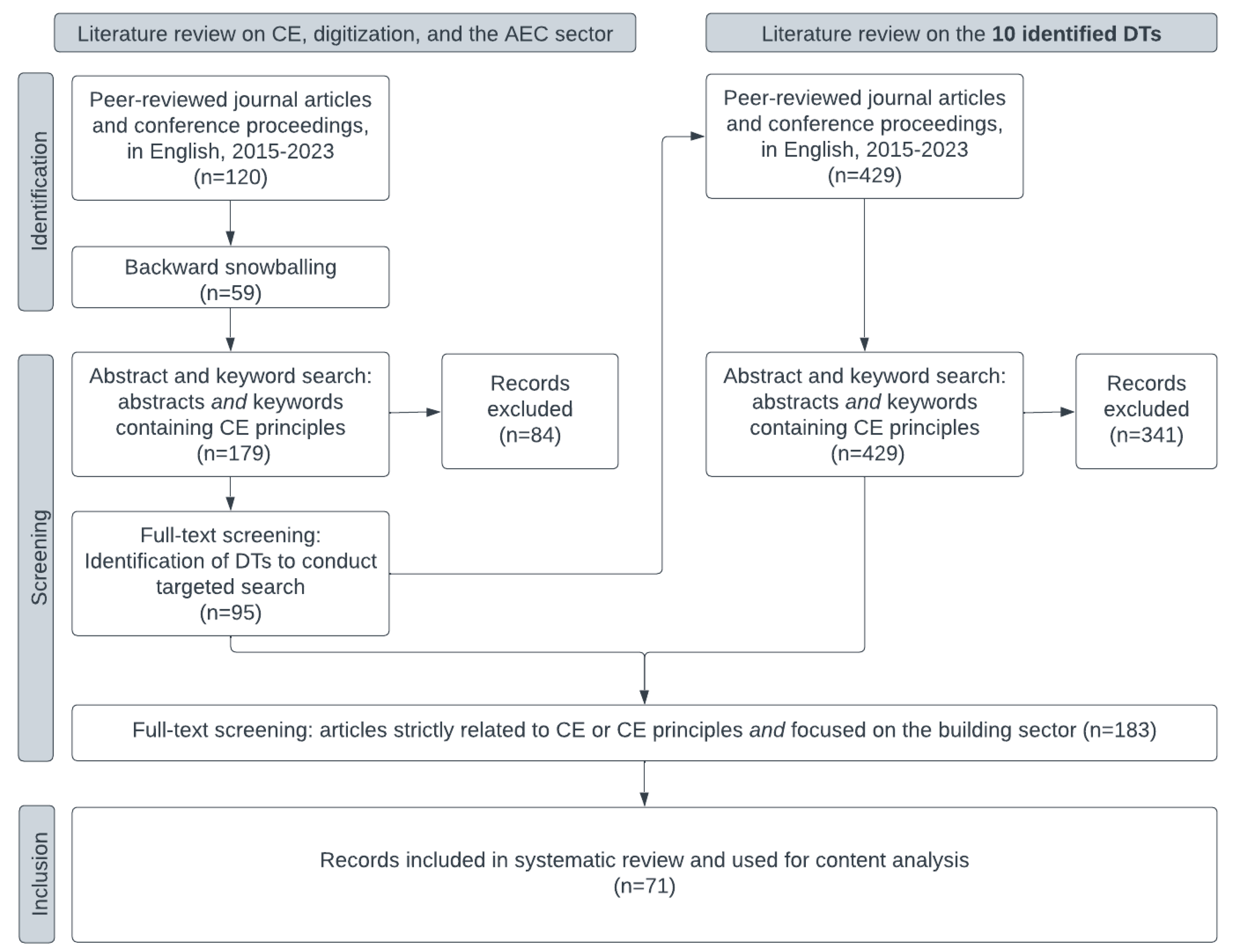
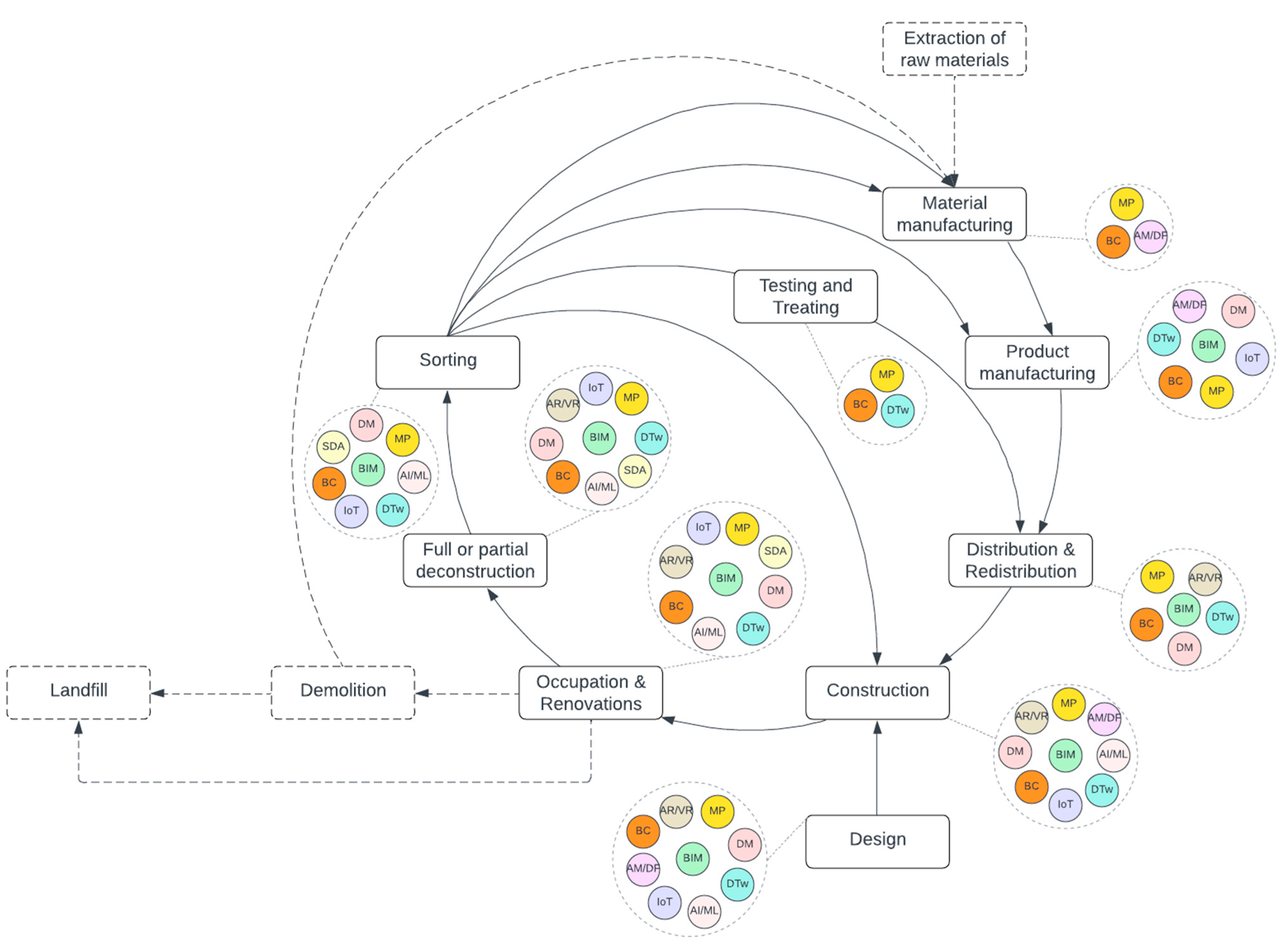
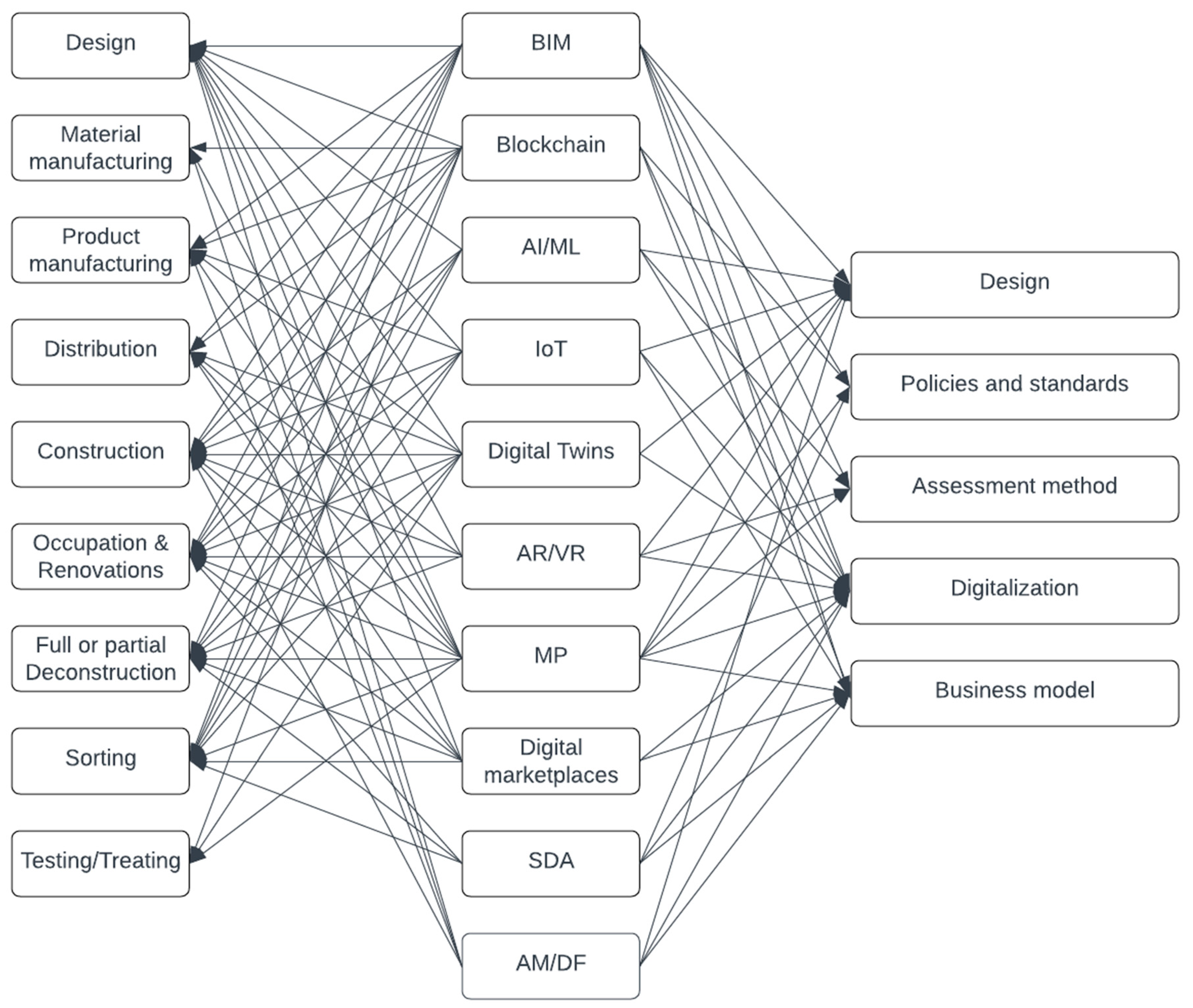
| Digital Tool | Applications and Benefits |
|---|---|
| Building information modeling (BIM) |
|
| Spatial data acquisition (SDA) |
|
| Artificial intelligence and machine learning (AI/ML) |
|
| Internet of Things (IoT) |
|
| Blockchain |
|
| Digital twin |
|
| Augmented reality and virtual reality (AR/VR) |
|
| Digital platform/marketplace |
|
| Material passports (MPs) |
|
| Advanced manufacturing and digital fabrication (AM/ DF) |
|
| End of Life: Design for Disassembly, Deconstruction, Reuse, Recycle | Environmental Impact Assessment |
|---|---|
 | 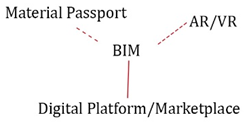 |
| Waste management | Lifecycle CE strategies |
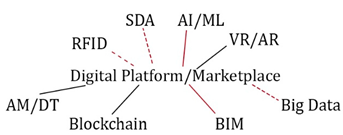 |  |
| Construction supply chain | Urban mining/material stock and flow |
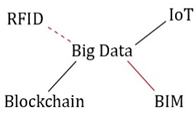 | 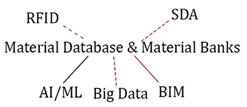 |
 | |
Disclaimer/Publisher’s Note: The statements, opinions and data contained in all publications are solely those of the individual author(s) and contributor(s) and not of MDPI and/or the editor(s). MDPI and/or the editor(s) disclaim responsibility for any injury to people or property resulting from any ideas, methods, instructions or products referred to in the content. |
© 2025 by the authors. Licensee MDPI, Basel, Switzerland. This article is an open access article distributed under the terms and conditions of the Creative Commons Attribution (CC BY) license (https://creativecommons.org/licenses/by/4.0/).
Share and Cite
Keles, C.; Cruz Rios, F.; Hoque, S. Digital Technologies and Circular Economy in the Construction Sector: A Review of Lifecycle Applications, Integrations, Potential, and Limitations. Buildings 2025, 15, 553. https://doi.org/10.3390/buildings15040553
Keles C, Cruz Rios F, Hoque S. Digital Technologies and Circular Economy in the Construction Sector: A Review of Lifecycle Applications, Integrations, Potential, and Limitations. Buildings. 2025; 15(4):553. https://doi.org/10.3390/buildings15040553
Chicago/Turabian StyleKeles, Cagla, Fernanda Cruz Rios, and Simi Hoque. 2025. "Digital Technologies and Circular Economy in the Construction Sector: A Review of Lifecycle Applications, Integrations, Potential, and Limitations" Buildings 15, no. 4: 553. https://doi.org/10.3390/buildings15040553
APA StyleKeles, C., Cruz Rios, F., & Hoque, S. (2025). Digital Technologies and Circular Economy in the Construction Sector: A Review of Lifecycle Applications, Integrations, Potential, and Limitations. Buildings, 15(4), 553. https://doi.org/10.3390/buildings15040553






